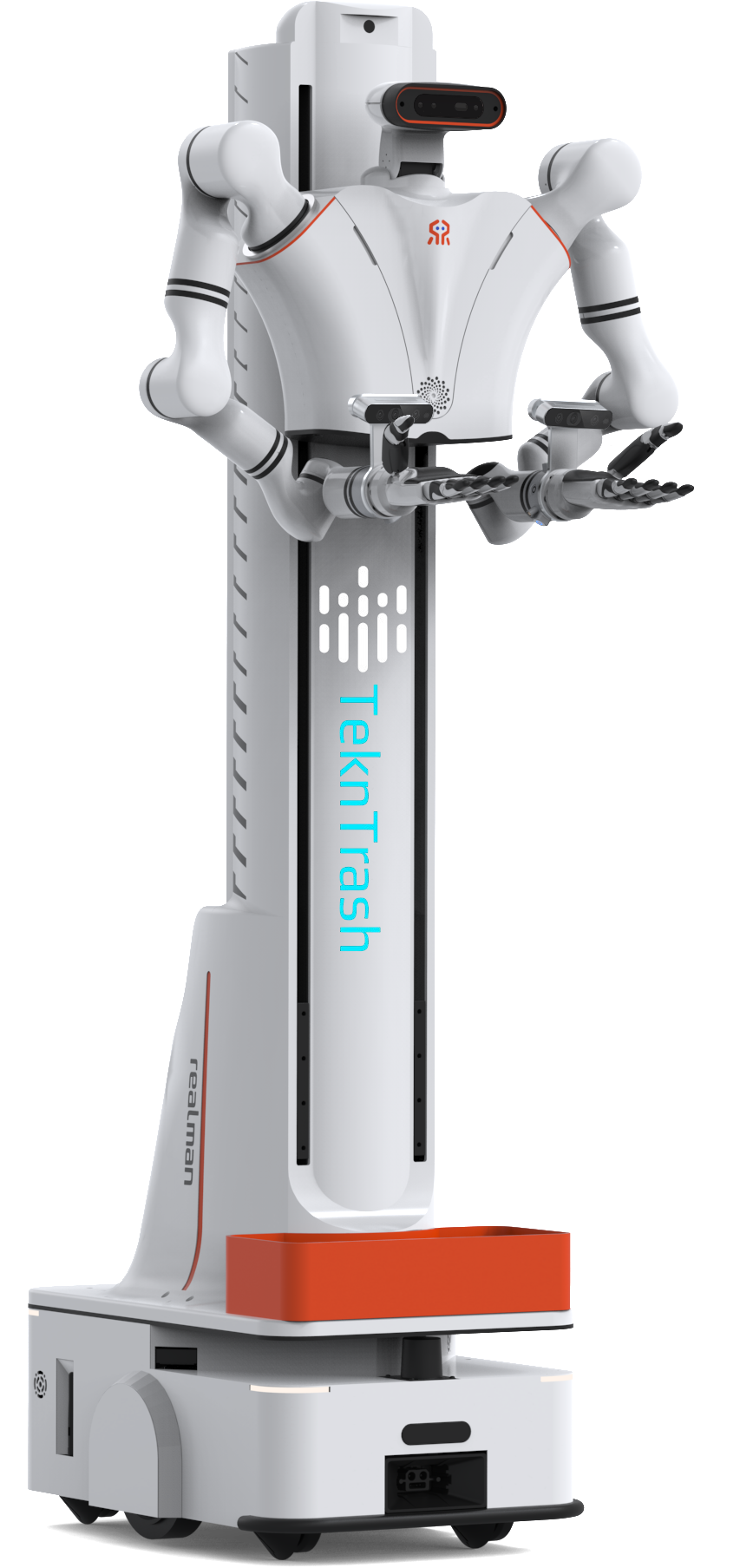
Top differentiators
1. Uses hyperspectral cameras to increase recognition due to the use of frequencies beyond the regular color spectrum (UV, X-ray, infrared, etc)
2. Cameras located at the start of the conveyor belt tracking waste as it moves and allocating it to robots along the line
3. Robots pick up the waste as instructed using grippers instead of suction cups which require constant cleaning
4. Robots have freedom of movement instead of solutions which are fixed and therefore cannot grab missed waste
5. ALPHA is truly a humanoid and, thus, ultimately designed to replace humans in all work aspects of recycling plants

Replacing humans in work degrading conditions
At TeknTrash, we have developed a humanoid called ALPHA (Automated Litter Processing Humanoid Assistant): robots designed to pick up trash from conveyor belts at recycling plants
Humans sort waste at an average rate of 30 to 40 picks per minute, but fatigue and decision fatigue lead to errors. Contamination items mixed with recyclables remains a persistent issue, with single-stream recycling (where all recyclables are collected in one bin) resulting in about 25% of material being contaminated, rendering it unsellable. In 2022, England dry recycling declined by 7.1% (0.4 million tonnes), partly due to quality issues affecting resale value.
Robots, by contrast, achieve higher purity rates, reducing bale rejection rates and boosting profitability. And this is one of the benefits of the humanoid we are developing: a humanoid able to work anywhere where waste is being handled: picking it up from the conveyor belts in recycling plants, carrying garbage cans to the truck, lifting up weights in processing plants, etc.
For we believe waste handling is unsafe, unsanitary, repetitive, and overall degrading: thus the perfect spot for a robot.
In fact, the waste and recycling sector is among the most hazardous industries in the UK: in the 2018/19 period, 4.5% of workers in this sector suffered from work-related ill health, a figure notably higher than the all-industry average of 3.1%. Additionally, the rate of non-fatal workplace injuries stood at 3.4%, surpassing the 1.8% average across all industries. Alarmingly, the sector's fatal injury rate is 17 times higher than the all-industry average, with seven fatal injuries reported in 2018/19ALPHA is, thus, a thorough solution which offers enormous advantages for the industry, society, and the environment
Technical Characteristics
Overall - Composed of a chest with 2 arms, a head, a lifting column, and a wheeled base, it can operate for up to 7 hours and charge in 3Lifting module - Installed on the top surface of the mobile base, the lifting module can go up and down 1 metre to ensure that the arms operate at a 2000mm maximum height, and 150mm/s maximum lifting speed. A monocular camera is installed at the center top back of the lift column. At about 1500mm above the ground, and has a monocular camera and microphone
Dual Arms - Each arm has 6 DOF, is fitted with a gripper, and between both they are able to lift up to 5 Kg, and a 3D camera with a field of view of 85 degrees horizontal * 58 degrees vertical and a depth range of 0.25 to 2.5m
Base - Carries functions such as autonomous navigation, autonomous motion, and autonomous obstacle avoidance, providing data such as lidar, depth camera, ultrasonic sensor, motor encoder, and IMU through API and HTTP protocols, and adjust the parameters. The base can process navigation, dynamic obstacle avoidance, autonomous positioning, map construction, and automatic charging. For navigation it employs a deep learning sensor camera, lidar, 1 ultrasonic safety touch edge and 2 ultrasonic, and 1 IMU+encoder
Head - Composed of pitching joint, rotating joint and binocular depth camera, allows a global perspective for accurately identifying objects and grasp, identifying obstacles around the robot arms or high-position obstacles and avoid block during motion. With 2 DOF, it has a binocular camera
Computing - Provided by a Nvidia Orin AGX with a GPU Ampere architecture with 2048 NVIDIA CUDA cores and 64 Tensor Cores, a CPU 12-core Arm Cortex-A78AE v8.2 64-bit CPU, 3MB L2 + 6MB L3 cache, DL Accelerator 2xNVDLA V2.0, Vision Accelerator PVA v2.0, Storage 64GB eMMC 5.1, Hard Drive 1G SSD, providing 275 TOPS of processing
Connectivity - Designed to work in groups of at least 2 units, ALPHA is permanently connected to the cloud thanks to its wifi interface. The cloud reads from a central camera and tells each unit which function it should perform: this is a radical approach to the usual approach of self-sufficient robots that depend on their sole resources and do not work as a team